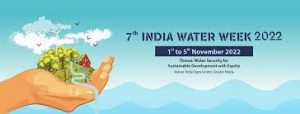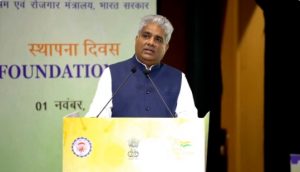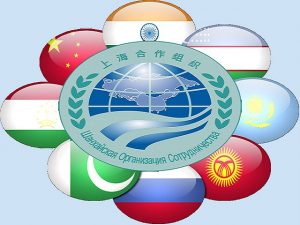Today Current Affairs: 3rd November 2022 for UPSC IAS exams, State PSC exams, SSC CGL, State SSC, RRB, Railways, Banking Exam & IBPS, etc
Table of Contents
Centre For Science And Environment Report On Natural Disasters:

According to a recent CSE report, India saw natural disasters almost every day in the first 9 months of 2022.
Key highlights of the report:
- India recorded extreme weather events on 242 of the 273 days from January 1 through September 30, 2022.
- These include heatwaves, cold waves, cyclones, lightning, heavy rainfall, floods and landslides.
- Most affected state: Madhya Pradesh
- Deaths: highest in Himachal Pradesh (359), followed by Madhya Pradesh and Assam.
- Lightning and storms were spread over 30 states and claimed 773 lives.
- Heat waves claimed 45 lives.
- Damage: Assam reported the highest number of damaged houses and animal deaths.
- Worst hit Regions: central and north-western India reported the highest number of days (198 and 195 respectively) with extreme weather events.
- In terms of human lives lost, central India topped the list with 887 deaths, followed by East and North East India (783 deaths).
- Reasons: Global warming-induced changes in the atmospheric and water system around the world.
One Nation, One ITR Form:

The Central Board of Direct Taxes (CBDT) has proposed a single income tax return (ITR) form for all taxpayers.
- There are seven kinds of ITR forms, which are used by different categories of taxpayers.
- According to the proposal, all taxpayers, barring trusts and non-profit organisations (ITR-7), will be able to use a common ITR form, which will include a separate head for disclosure of income from virtual digital assets.
- The proposed draft ITR takes a relook at the return filing system in tandem with international best practices.
- The draft form aims to make it easier to file returns and to considerably reduce the time taken for the job by individuals and non-business-type taxpayers.
7th Edition Of India Water Week:

President Droupadi Murmu recently inaugurated the 7th edition of India Water Week.
- It was conceptualized and organized for the first time in 2012.
- It is an initiative of Ministry of Jal Shakti, Department of Water Resources, River Development & Ganga Rejuvenation, Government of lndia
- The theme of the 7th India Water Week is ‘Water Security for Sustainable Development and Equity’.
- The function is organised by the ministry of water resources, river development and Ganga rejuvenation in an effort to raise awareness and conserve and use water resources in an integrated manner.
- The event will address the issues of sustainability of water resources development and management in line with the sustainable development goals.
- Denmark, Singapore and Finland are the partner countries for IWW 2022.
Ban On Using Aceclofenac In Cattle:

Indian Veterinary Research Institute (IVRI) has recently demanded a ban on using aceclofenac in cattle after a new study showed that the drug metabolises into diclofenac in water buffaloes as it does in cows.
- Aceclofenac is the prodrug of the non‐steroidal anti‐inflammatory drug (NSAID) diclofenac.
- Aceclofenac in water buffaloes poses the same threat to vultures as it is a pro-drug of diclofenac.
- Aceclofenac turns into diclofenac soon after it enters the livestock.
- Vulture Action Plan 2020-2025 also mentions the aceclofenac as ‘toxic’, along with other drugs like nimesulide and ketoprofen.
- Diclofenac is an anti-inflammatory drug.
- It was banned for veterinary use by the Government of India in 2006.
- It was found to be the main cause of a dramatic decline (99 per cent) of the vulture population across Asia.
- The drug caused accidental poisoning in raptors after they fed on carcasses of cattle injected with it.
70th Foundation Day Of EPFO:

Union Minister for Labour & Employment, Environment, Forest & Climate Change, Shri Bhupender Yadav recently inaugurated the 70th Foundation Day of EPFO(Employees’ Provident Fund Organisation)
- It was established in 1952.
- It is under the administrative control of the Union Ministry of Labor and Employment.
- It is tasked to assist the Central Board of Trustees in implementing the following three schemes for the workforce engaged in the organized sector in India:
- EPF Scheme 1952;
- Pension scheme 1995 (EPS); and
- Insurance scheme (EDLI).
- It is also the nodal agency for implementing Bilateral Social Security Agreements with other countries on a reciprocal basis.
- In 2014, union government launched Universal Account Number (UAN) for Employees covered by EPFO to enable PF number portability.
World Cities Day 2022:

World Cities Day is celebrated on 31st October every year to highlight the need for international cooperation to promote global urbanisation and address its challenges.
- According to the United Nations, seven of every 10 people in the world will live in cities by 2050.
- Theme for 2022: Act Local to Go Global.
- On 27th December 2013, the United Nations General Assembly (UNGA) established World Cities Day through a resolution.
- The first celebration took place in 2014.
- The second United Nations Conference on Human Settlements in 1976 influenced the UNGA’s decision to establish World Cities Day.
- The UN-Habitat programme promotes the development of sustainable cities in line with SDG 11 goals.
- The United Nations Human Settlements Programme (UN-Habitat) is the United Nations agency for human settlements and sustainable urban development.
- It conducts the annual Urban October programme for this purpose which begins on the first Monday of the month and ends on 31st October with World Cities Day.
Carbon Credit Market:

The Ministry for Power, New & Renewable Energy is taking steps to establish a Carbon Credit Market to help the country meet its Nationally Determined Contributions (NDC).
- A carbon credit (also known as carbon offset) is a credit for greenhouse emissions reduced or removed from the atmosphere by an emission reduction project, which can be used by governments, industry, or private individuals to compensate for the emissions they generate elsewhere.
- Those that cannot easily reduce emissions can still operate, at a higher financial cost.
- Carbon credits are based on the “cap-and-trade” model that was used to reduce sulfur pollution in the 1990s.
- One carbon credit is equal to one metric ton of carbon dioxide, or in some markets, carbon dioxide equivalent gases (CO2-eq).
- Negotiators at the Glasgow COP26 climate change summit in November 2021 agreed to create a global carbon credit offset trading market.
- The Kyoto Protocol provides for three mechanisms that enable countries, or operators in developed countries, to acquire greenhouse gas reduction credits:
- Under Joint Implementation (JI), a developed country with relatively high costs of domestic greenhouse reduction would set up a project in another developed country.
- Under the Clean Development Mechanism (CDM), a developed country can “sponsor” a greenhouse gas reduction project in a developing country where the cost of greenhouse gas reduction project activities is usually much lower, but the atmospheric effect is globally equivalent.
- The developed country would be given credits for meeting its emission reduction targets, while the developing country would receive the capital investment and clean technology or beneficial change in land use.
- Under International Emissions Trading (IET), countries can trade in the international carbon credit market to cover their shortfall in Assigned Amount Units (AAUs).
- Countries with surplus units can sell them to countries that are exceeding their emission targets under Annex B of the Kyoto Protocol.
Carbon Markets:
- A carbon market turns emission reductions and removals into tradeable assets, thus creating incentives to reduce emissions or improve energy efficiency. The carbon markets can be compliance and voluntary.
- Parties with commitments under the agreement agreed to limit or reduce their greenhouse gas emissions between 2008 – 2012 to 5.4% which were well below the levels of 1990.
- Emissions trading, as set out in the Kyoto Protocol, allowed countries to sell the excess capacity of emission units to countries that had levels well over their targets.
Meeting Of The SCO Council Of Heads:

China hosted a meeting of the Shanghai Cooperation Organisation (SCO) Heads of Government
- The SCO Heads of Government meet is held annually to focus on the trade and economic agenda of the organisation and approves the SCO’s annual budget.
- India has taken over as Chairperson of the SCO for 2023, and will host leaders of all SCO countries at a summit in Delhi expected in mid-2023.
- Earlier, the SCO summit 2022 was held recently in Samarkand, Uzbekistan.
Highlights of the Meeting:
- The heads of delegations of the SCO member states exchanged views on key issues of global and regional development, discussed priority steps to increase trade, economic, cultural, and humanitarian cooperation within the SCO.
- India stated that its total trade with SCO Members is only USD 141 billion, which has potential to increase manifold.
- The bulk of India’s trade with SCO countries is with China, which crossed USD 100 billion in 2022, while trade with Russia is less than USD 20 billion.
- Trade with Central Asian countries is less than USD 2 billion, and with Pakistan it is about USD 500 million.
- While taking aim at China’s BRI (Belt and Road Initiative), which passes through parts of Pakistan occupied Kashmir (PoK), India said that Connectivity projects should respect the sovereignty and territorial integrity of Member States and respect international law.
- India underlined the need for better connectivity in the SCO region built on the centrality of interests of Central Asian states, which will unlock the economic potential of this region in which Chabahar port and the International North South Transport Corridor (INSTC) could become enablers.
- India drew attention to its commitment in fighting the challenge of climate change and also, its achievements made in this direction.
- India pitched for more trade through Iran’s Chabahar port and the INSTC that India is a part of, aiming to improve bilateral trade with Central Asian countries.
- A joint communique was issued after the meeting naming all countries except India, which reaffirmed their support for the BRI, “including the work to promote the alignment of the ‘Belt and Road’ construction with the construction of the Eurasian Economic Union”.




